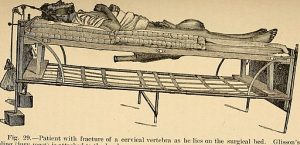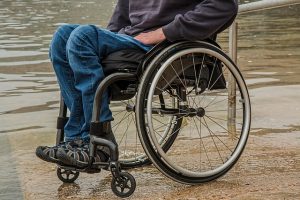A History of Spinal Injury Treatments
The first known record of a spine injury is from about 3000BC. It makes you wonder…how did they treat spinal injuries back then? Here’s a brief glimpse into the history of spinal injury treatments.
Early History of Spinal Injury Treatments
Spinal Traction
There wasn’t much documentation about the treatment methods for these injuries back then. By 450BC the records started to indicate the use of traction.
Traction is basically the decompression of the spine via manual or mechanical methods. It has been carried out in various ways throughout history but the concept remains relatively the same. The idea is that the spinal cord is stretched to both straighten it and reduce the intervertebral compression. This picture shows a traction table used around 1810.

Source: Wikimedia, Helferich, Heinrich, 1851- [from old catalog] [No restrictions]
Laminectomy or Spinal Decompression Surgery
As early as 625AD there are records of surgical intervention for spinal cord injuries. Paul of Aegina is considered the first person to perform the surgical treatment, laminectomy.
If you remember from our series on the spinal cord anatomy, the lamina is part of the irregular shaped portion of each vertebrae. During a laminectomy this portion of one or more vertebrae is removed to allow more room for the spinal cord.
Even though we know at least one laminectomy was performed as early as the 600’sAD there wasn’t much documented about these procedures again until the early 19th century. Back then there was controversy about the effectiveness of laminectomies and whether they should be performed. As advancements were made in surgical technique, anesthetics and infection medications the surgery became more popular. With the advent of microscopes and minimially invasive surgery, the laminectomy procedure continues to be optimized and variations of this surgery remain one of the most popular spinal surgeries to this day.
Prognosis for Individuals with Spinal Injuries
Up until the 19th century the prognosis for someone with a spinal injury was not good. In most cases a spinal injury accompanied by paralysis lead to death within a few weeks. The main causes of death were infections related to bed sores and infection or renal failure due to loss of bowel and bladder function.
 It wasn’t until the mid-19th century that significant progress was made in managing a patient with spinal injuries and paralysis. Doctor Wilhelm Wagner and one of his pupils wrote an in depth book about how spinal injuries should be treated and outlined follow up care for the patient to effectively deal with bed sores and loss of bladder function.
It wasn’t until the mid-19th century that significant progress was made in managing a patient with spinal injuries and paralysis. Doctor Wilhelm Wagner and one of his pupils wrote an in depth book about how spinal injuries should be treated and outlined follow up care for the patient to effectively deal with bed sores and loss of bladder function.
Treatment for Spinal Injuries in the 20th Century
With the first World War came an increase in the frequency of spinal cord injuries. As a result, several countries put together medical units to deal specifically with these injuries. These new units focused on treatment of bed sores and bladder control. There continued to be a high mortality rate for individuals with these injuries but much more emphasis was placed on patient care after the injury was healed. Different medical groups began collaborating on their methods for reducing bed sores and avoiding renal failure and met to discuss their findings.
Meanwhile, in the United States a man named Charles Frazier began studying and documenting the treatment methods for spinal injuries. He translated and summarized findings from several centuries worth of records and believed that a patient with a spinal cord injury could be successfully treated.
Based on the work by these groups in the early 20th century the mortality rate for spinal injury patients was significantly reduced.
Modern Day Treatment for Spinal Cord Injuries
Unfortunately, modern medicine still doesn’t provide a way for us to reverse spinal cord damage from a spinal injury. Therefore, modern day treatment is focused on treating the effects of the paralysis and helping the patient live as normal a life as possible. In that way, the focus of the treatment hasn’t changed drastically in the past hundred years. However, technological advances have helped provide tools (ie: motorized scooters, voice computers, etc) that can positively impact the patient’s quality of life.
In addition, the importance of preventing further damage to the spinal cord is better understood and appreciated than it was in the past. As a result, first responders and medical professionals have the tools and training to immobilize individuals following a potential spinal injury as a way of preventing further injury to the spinal cord.
Hopefully, in years to come, medical research will identify a way to reverse damage to the spinal cord to change the history of spinal injury treatments.
References
- https://pmj.bmj.com/content/81/952/108
- https://www.nature.com/articles/3100378.pdf
- https://spinerf.org/wp-content/uploads/2015/08/OLeary-A-Brief-History-of-the-Evolution-of-Lunmbar-Spinal-Surgical-Decompression.pdf
- https://www.nichd.nih.gov/health/topics/spinalinjury/conditioninfo/treatments
